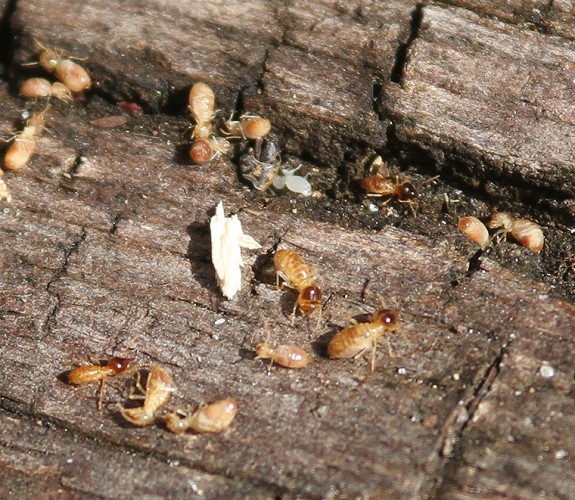
INDIAN RIVER COUNTY — A voracious, exotic termite with a dark cone head has made its way north as far as Fort Pierce, alarming scientists and pest control experts, who had been struggling to keep the insect under control some 100 miles south of here.
“Bad news. Too close for comfort,” said entomologist Barbara Thorne, a barrier island resident and leading expert on the destructive Caribbean tree termite.
On Thursday afternoon, two termite inspectors climbed a rickety two-story ladder to board a yacht in dry dock in north Fort Pierce, 15 miles south of 32963.
Their mission was to determine if the dreaded insect from the Caribbean, which threatens to take hold in the area and spread further north, was still embedded in the teak floors, walls and hand-carved cabins of a 50- foot Marine Trader.
Just the day before, scientists including Thorne, state agricultural administrators and pest control experts held an emergency meeting in Dania Beach to sound the alarm that efforts to stop the nasutitermes termite needed to go into overdrive before the very destructive termite spread.
But the discovery in Fort Pierce suddenly turned those warnings into a disturbing reality.
Fort Pierce yacht owner Jerry Anderson shook his head in disbelief. He had left his beautiful Taiwanese-made boat in the northern Dominican Republic near Puerto Plata for about a year.
When he went down in the summer to bring it back to Fort Pierce, he was shocked to find a basketballsized nest – home to hundreds of thousands of termites – embedded in the ceiling just off the kitchen. The bugs had crafted mud channels up and down the wooden walls of the boat’s interior.
With an over-the-counter termite pesticide, Anderson went to work hacking into the nest and spraying.
“He did a good job with that nest,” said pest control expert Jackie Valencia, while surveying the destroyed nest.
“But the problem was he couldn’t see other nests that were behind walls.”
So, with the best of intentions, Anderson made the crossing to Fort Pierce in the summer, thinking he had killed all of the termites on his boat. But in September, after the boat had been in dry dock for a few months, he noticed new, telltale mud channels made by the termites and called Valencia of Wipeout Pests and Termites in Indian River County.
She and her crew found two more basketball-sized nests – one under overhangs on the bow and another behind cabinets near of one of the staterooms.
“The termites had even gotten into the refrigerator,” said Valencia. She immediately took samples to well-known University of Florida entomologist and termite expert Rudy Scheffrahn, who also identified the nasutitermes termite in Dania Beach over a year ago, as well as in 2001. It was believed to have been eradicated in 2003 but was not.
In Dania Beach, hundreds of colonies of the termite are infesting businesses and neighborhoods. The nasutitermes cone head termite is considered particularly alarming because of its fast growth rate and amazing adaptability, which enables it to live and thrive almost anywhere.
“In a house, a tree, a couch – you name it,” said Thorne. And, obviously, in a boat.
Between 1984 and 2011, according to the U.S. Department of Agriculture, exotic termites have been intercepted 58 times entering Florida – mostly on boats from the Caribbean and Central and South America. The Anderson yacht is the most recent Florida entry on record.
“From the size of the colonies on the Fort Pierce boat, they had to have been there for three to four years, which means you would have mature, winged termites that could fly out and start new colonies,” said Scheffrahn.
The only hope, said Valencia, is that they tend to fly out with the first hard rains of the season, which came in May, before the boat got to Fort Pierce.
But, like Scheffrahn, Thorne was not totally comforted by that scenario. “I never trust them,” she said. “The majority may have flown before the boat got to Fort Pierce. But you can’t be certain that residuals didn’t make it here and fly off to start new colonies.” If they did, it will take about three years to find them because the new colonies will be so small.
“Like finding a needle in a haystack,” said Scheffrahn.
Meanwhile, they could be getting closer and closer to Vero Beach. The Wednesday meeting in Dania Beach was a call to arms for termite scientists, pest control teams and state agricultural administrators because efforts to stop the termite there have been sporadic because of limited funding and politics that have curtailed the search and eradication of the pest.
“You might call what has happened ‘analysis paralysis,’” said Thorne, who, on Wednesday, found live nasutitermes termites in a branch on the grounds of the Fishing Hall of Fame, where the emergency meeting was held. Colonies spotted there a year ago were not successfully eradicated, despite state efforts.
About 100 nearby homes and yards have also become infested and have ugly, telltale mud channels going up walls inside. Empty home are especially vulnerable.
At Wednesday’s emergency meeting, discussions became contentious because state agricultural administrators have taken over the eradication program which formerly included UF entomologists and pest control technicians. Overworked with little money, they are fighting a losing battle.
“We need everyone involved,” said UF scientist Scheffrahn. “Like Barbara Thorne, I want everyone to work together to get the job done.”
Meanwhile, in Fort Pierce, Anderson, a retired navy lieutenant commander, is spending thousands of dollars to ferret out the termites, kill them and repair his boat.
“I’m really trying to stop the problem here,” he said.
“We need to do everything we can to control this termite because if we don’t, we’re looking at a huge financial investment in the future,” Thorne said.



